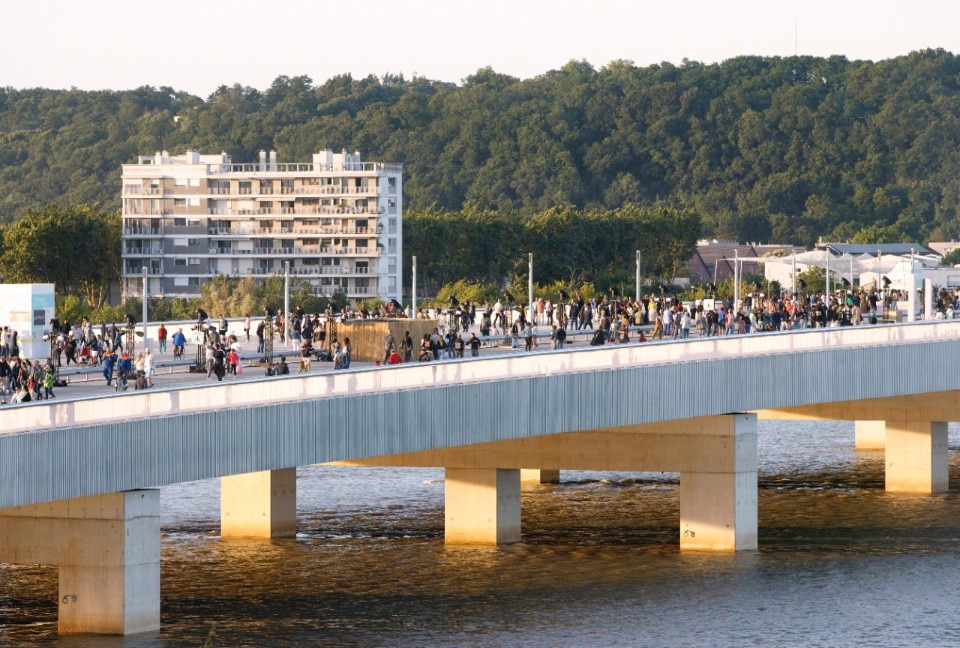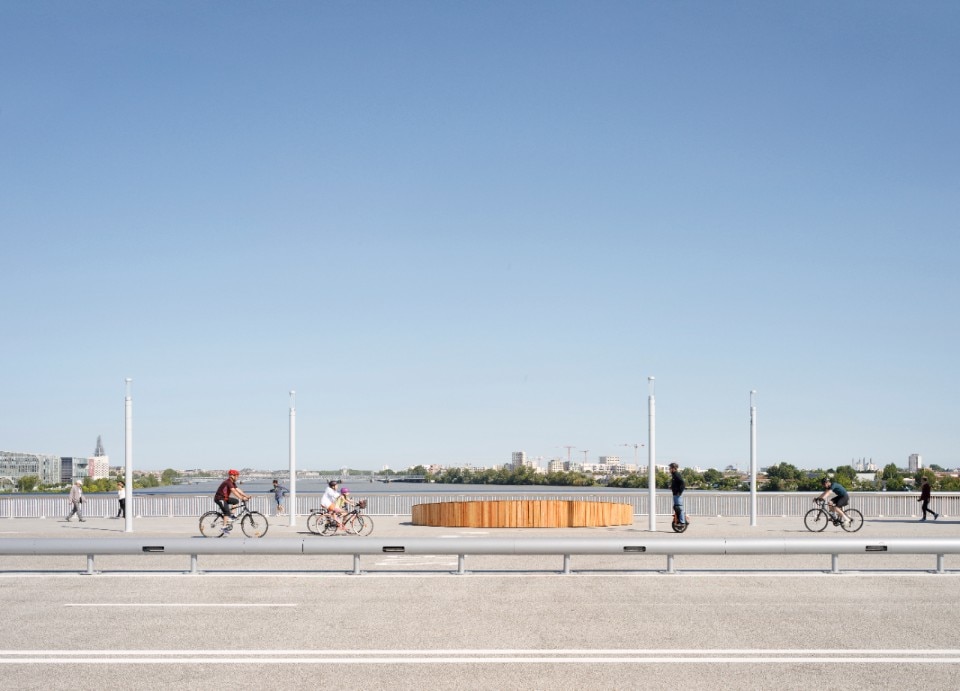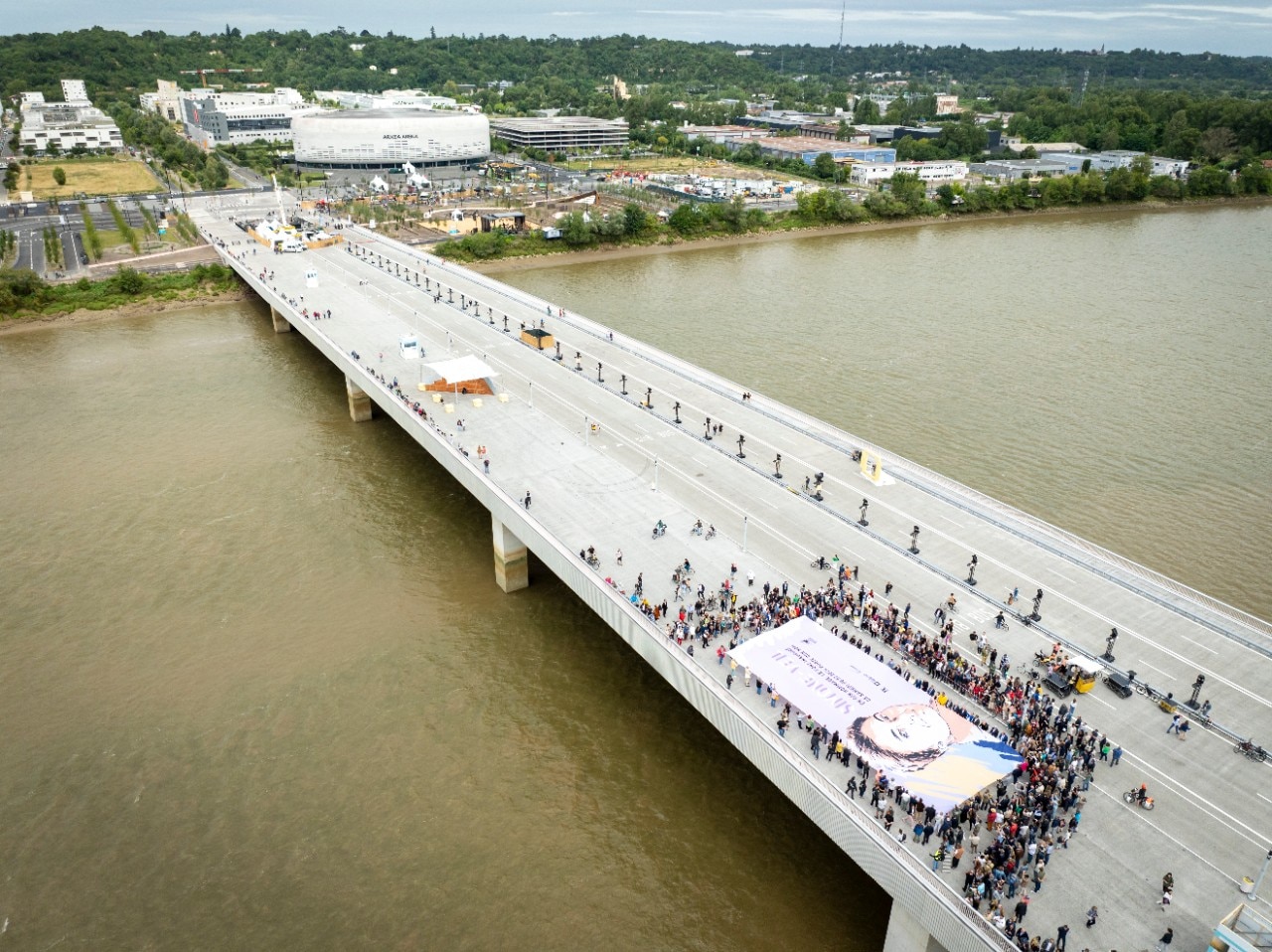A new bridge has the potential to convey all the metaphors of connectivity, togetherness, and possibilities for new communities. Tempting in these times of entrenchment and separation: left and right banks have long been kept apart in Bordeaux, the Garonne an imagined obstacle to the joining of both sides to constitute a metropolis. The new Simone Veil bridge inaugurated by the city of Bordeaux this summer has been more than ten years in the making, and is celebrated as the eight of the city’s possible crossing points, which first was made possible in 1821 thanks to the Pont de Pierre. The Simone Veil bridge sits right at the juncture of three political communities: Bordeaux, Floirac and Begles, its completion effectively connecting them for the first time.
The bridge as the public space of the Garonne creates a new possible relational condition to the river which the city had heretofore made its obstacle or tried desperately to overpass.

Rem Koolhaas, partner in charge of the project together with Chris van Duijn, have made the choice of a design that conveys sobriety and rejects artifice. Indeed, the bridge is the most symbolic object onto which one can make a clear and visible statement in opposition to the instrumentalization of infrastructure to create the image of a place. While bridges are simply meant to establish continuity, enhance speed in dense areas or expand possibility to reach destinations across complicated terrain, they have been subject to unnecessary expressiveness, becoming infrastructures that serve the function of baptizing a place or landscape. Which is to say, infrastructure with postcard ambitions.
The Simone Veil bridge opposes the idea of unnecessary expenditure to transform the very notion of bridge as a piece of infrastructure into something else which is neither simple functionality nor bombastic architectural expression. OMA’s design is a new social tool waiting to be appropriated by this community to-be.

Indeed, the new Simone Veil Bridge is anything but a grand gesture. A non-iconic icon, the result of a rerouting of investment in remarkability towards the creation of a new urban space. Equipped for programmatic possibilities, the bridge is a platform of anticipation, a public space where a series of events can unfold. It is wide enough to include as much space for pedestrians and bikes in addition to space dedicated to programming popular events.
Onto this extension of the city, it is possible to “plug in” and host festivals, concerts, but also exercise, meet up, sit and dwell…The overall gradient kept at a constant rate below four percent makes it a monumental statement of accessibility and sociability all the while ensuring functionality and mobility either motorized, or human-powered.

But the question which the Simone Veil bridge formulates goes beyond it posing a new definition of infrastructure - surpassing itself as either icon or feat of functionality to provide spaces of sociability- and is one posed to architecture which is to say: how to expand the city?
Bordeaux’s banks have been longstanding objects of architectural speculation, addressed most memorably in the now canonical 1989 exhibition “Bordeaux Port de la lune” at Arc en Rêve which asked seven firms, including OMA, to imagine what a new modernity could look like for Bordeaux, consecrated World Heritage Site by UNESCO just a year prior in 1988.
The city eventually adopted the 1992 plan proposed by Dominique Perrault the result of which symbolically served to maintain a clear divide between the idea of the city as that made of bricks and stone and the image of nature. In this plan, the historical center on the right bank was to be kept intact with some developments radiating outward to the south and north while on the left bank were reserved areas for most of the city’s parks and green spaces, the Garonne a psychological and physical divide maintaining the separation between the two.

We by now acknowledge this nature-city divide to be a fantasy and an ahistorical one, as nature has always been essential to cities, and urbanity the mere historical development of the conditions made possible by nature itself. The Simone Veil Bridge works to expand the city onto the Garonne and enact a departure from this nature-city divide by becoming Bordeaux’s new public space, where one can take part in the urban condition at a new distance from the historical city, of which the bridge offers a panorama. The bridge is a platform, an urban extension that expands the historical condition of Bordeaux with a social possibility. The piece of infrastructure is transformed to surpass itself as a new technology of connectivity.
The bridge as the public space of the Garonne creates a new possible relational condition to the river which the city had heretofore made its obstacle or tried desperately to overpass. With spaces reserved to the new community it chiefly concerns, it opens the possibility to take part in the experience of the metropolis. By being more than transitory, a space where a series of events can take place, the bridge enlarges the idea of Bordeaux to finally include the river itself as public space. Indeed it is the site where the exhibition of the city, past present and becoming is possible and put in relation with its primary ecological and historical site - the Garonne itself.

Beyond the virtue of expanding without artifice, connecting to the existing beauty of the historical city with a social project on the Garonne makes the Simone Veil Bridge a necessary extension of the city. Rem Koolhaas himself has made Bordeaux the object of many projects for thinking the city, beyond Mutations the more recent master plan EuroAtlantique. The formal minimalism of the bridge might well be the synthesis of this architectural sedimentation, to result in an infrastructural prototype that enlarges an original modernity by way of social emancipation. A valid theoretical proposal that the French capital - which possesses the same historical and preservationist imperatives as Bordeaux - could also consider, as itself has yet to bridge its original modernity to either include its more recent expressions or acknowledge its original ecological one.
Opening image: OMA, Simone Veil Bridge. Photo JB Menges, courtesy Bordeaux Metropole

A Brutalist masterpiece frames the novelty signed 24Bottles
Giancarlo De Carlo's Collegi in Urbino is hosting a campaign for a signature product of 24Bottles: the brand's first titanium bottle, designed under the banner of essentiality.












